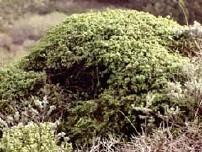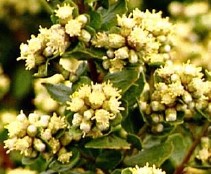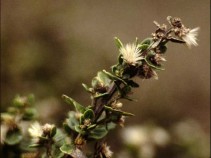

Common Names:
Coyote Bush, Chaparral broom, Bush Baccharis, Dwarf Chaparral Broom
Genus: Baccharis
Species: pilularis

Coyote brush is a common chaparral plant in California and Oregon. It can be found all over California from San Diego County to Oregon, coastal sage scrub and chaparral, hillsides and in canyons below 2500 feet. But like the coyote of legends, it has some pretty ingenious tricks up its s(leaves) as far as survival is concerned.
Strangely, Coyote brush is part of the Sunflower Family (Asteraceae), even thought it looks nothing like a sunflower.
The name Baccharis comes from the Greek name "Bakkaris", for plants with fragrant roots. Pilularis refers to the sticky globs on its flower buds.
Coyote brush is a wiry and woody perennial evergreen that looks like a bush. One of the tricks Coyote brush uses is to take on a different shape depending on where it lives. Shaped by salt spray and winds, it hugs low to the ground and forms a ground cover on dunes, ridges and plains. In protected places, like moist canyons and northwest slopes, it grows into tall, erect to mounded shrubs.
Its numerous small and stiff grey-green leaves are jagged on the edges. Egg-shaped and from 0.5-1.0 inch long, the leaves have a waxy coating that reduces the amount of moisture lost to evaporation into the air. Best of all, the leaves are fire-retardant, meaning that they have a chemical makeup that reduces their ability to catch on fire. These evergreen leaves tend to crown the upper branches of Coyote brush. The leaves become fragrant and sticky with resinous oils on hot summer days. These oils are unappetizing and may protect the plant from being eaten.


Coyote brush is dioecious, meaning that it produces male and female flowers on different plants. Blooming between August and December, the white fluffy female and yellowish male flowers grow on separate shrubs. The male flowers are stubbier, short, flattish, with a creamy white color. The yellow pollen on the male flowers smells like shaving soap. The female flowers are long, whitish green and glistening. The many flowering heads bloom in clusters on leafy branches. Seeds are small black nuts and hang off a fluffy tuft of hair called a pappus. From October to January the pappus catches the wind and blows away, like dandelions, helping Coyote brush spread its seeds.
Another trick for survival is Coyote shrub's large root system which extends many yards out from the plant to make use of any rain that might fall in its dry habitat. Branches grow from a crown that forms at the ground and spreads out. Because of the dense root crown, Coyote brush is able to survive and regenerates quickly from such things as fire, floods, or clearing.
Coyote shrubs provide shelter for wildlife and nectar for bees, butterflies and other insects. It is a nurse plant for degraded soil. It is called a pioneer species because it is one of the first shrubs to appear after other plants have been removed by cultivation or fire.
Coast Miwok Indians used the heated leaves to reduce swelling, and some Native Indians used the wood from this bush to make arrow shafts and for building houses. Early pioneers called it "fuzzy wuzzy" because of its silky-haired seeds.
Luckily Coyote brush is very common because of its many tricks for survival, like adapting its growth pattern to the environment, having small wax-covered, drought-resistant, fire-retardant leaves that taste bad, and its large root system.
Bibliography:
"Asteraceaa (Sunflower)
Family Pt 3", http://plants.montara.com/ListPages/FamPages/Astera3.html#bacpil,
12/17/05
"Coyote Bush --Nature Guide--Pelican
Network",
http://www.pelicannetwork.net/fg/coyote_bush/coyote_bush.html,
12/17/05
"Coyote Bush",
http://geolit.org/rushranch/coyotebush.htm,
12/17/05
"Plant Field Guide",
http://www.nps.gov/goga/parklabs/library/plantguide/white/coyotebrush.htm,
12/17/05
Images:
bacpil.JPEG, bacpil2.JPEG, male_flower.jpg
http://plants.montara.com/ListPages/FamPages/Astera3.html#bacpil